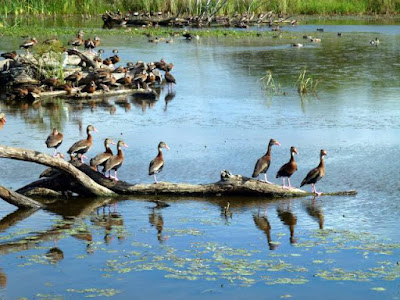From Seminole we
drive south, following the Mexican border. 200 miles down the road is Laredo
and lake Casa Blanca, another state Park where we’re staying for two nights to
break the journey. It’s a pleasant stop, with plenty of pitch space. The lake
and fishing pier takes a good photo in the late sunlight, with a heron on the
pier.
The park is mainly
aimed at boaters and fishermen, but has some wildlife interest like roadrunners
and water birds, including osprey. We also came across this odd Spanish style
building. Apparently an ex-museum, unused and boarded up, but structurally
solid. Pity it can’t be used for the fisherman, or for general recreation, or
even a café.
The state parks,
including the camping areas, are generally well run with the exception of the
toilet/shower facilities. These Spartan blocks, of assorted layouts and sizes, were
clearly designed by boot camp architects. For example, communal men’s showers at
one campsitel! Toilet doors often had no locks, and Jane’s showers provided a
dead scorpion plus an enormous dangling spider. Shower curtains missing in many
showers. We’re adventurers at heart, so no big problem; anyway, the state parks
are cheap and the wildlife fascinating.
We leave Casa Blanca
and travel the 100 miles to Falcon Lake for a three night stay. This is a wildlife
visitors to our pitch, a peccary or javelina, a small hog. It’s edible, but no
guns allowed in the parks, so the javelina lives to grunt another day. Its
Spanish name comes from the javelin-sharp teeth that it will use, with tusks,
if cornered.
The Mexican border
runs across Falcon Lake that was created by damming the Rio Grande River. The frontier
runs down the centre a mile away, so it’s Trump’s front line so to speak.
Plenty of police and Border Patrol vehicles around, but that’s no different
from previous years when we’ve been along the frontier at the
California/Arizona end. The US also use
surveillance balloons in this area that use radar equipment to detect drug and
illegal immigrant activity. This isn’t a new Trump initiative as they’ve been
in operation for some years. This is what they look like at ground level.
As if to emphasise that border issues go way back, here’s this cracked
and yellowed notice from Falcon Lake. When the notice was put up the sheriff
was probably still patrolling on a horse.
Our mobile phones
pinged, “Welcome to Mexico”. Our calling plans allow internet use in the USA
and calls back home at no extra charge. But the phone will pick up the
strongest signal, and here that’s coming from Mexico. If you then use the phone
it’s £2.00 per minute for calls and similar stiff fees for other services. Solution:
turn off phone immediately.
However, birdsong
was free. This is a vermilion flycatcher on a dark afternoon.
Nice walks on good
paths, so you can see where you’re stepping (rattlesnake country). In most
parts, the scrub is so thick the lake is hidden. That’s me by the tree, not an
illegal immigrant. He’s taking the photo.
Falcon is awash
with butterflies, especially in their butterfly garden. Texas has more species than
any other state. One particular bush, the Rio Grande Bee-bush attracts them in
their hundreds.
Lots more birds,
including an osprey eating its fish on the telegraph pole by our pitch, so a
great back-to-nature time, but after three state parks one after the other we
are ready for the comforts of a good commercial site. We now head for the
southern tip of Texas, near the Gulf of Mexico, to Llano Grande RV Resort.



















































